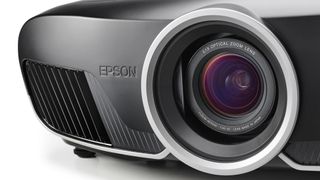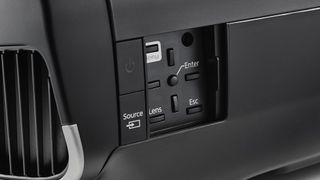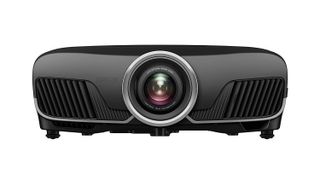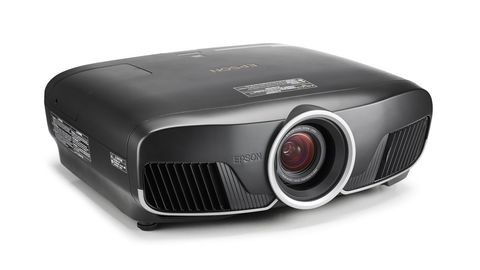TechRadar Verdict
The Epson EH-TW9400 is a superb home cinema projector that delivers a winning combination of performance and high-end specs. While not technically 4K, it produces bright, detailed and saturated HDR images that are sure to please. It’s also competitively priced, with features that can put models costing twice as much to shame. This is the very definition of a big-screen best buy.
Pros
- +
Impressive big-screen images
- +
Excellent color reproduction
- +
HDR10 and 3D compatible
- +
Motorized lens controls
- +
Superb value
Cons
- -
No built-in speakers
- -
Dust blob potential
- -
Blacks could be deeper
- -
Motion not its strong point
Why you can trust TechRadar
One-minute review
The Epson EH-TW9400 – or the Epson Pro Cinema 6050UB as it's known in the States – will set you back £2,549/$3,999, but in terms of performance, specifications and features, no other home cinema projector comes close.
This three-chip LCD model is competing with single-chip DLP models that require a color wheel, and thus suffer from rainbow artifacts. Because of that, this projector is capable of bright, detailed, and wonderfully saturated images. There’s also a low input lag, support for HDR10, and even 3D (if that still floats your boat), making this a cracking all-rounder.
Epson includes a host of higher-end features that are not only absent from competing projectors, but also not found on others costing over twice as much: there are fully motorized lens controls, making setup easy, and there’s even a lens memory for those using a scope ratio (2.35:1) screen. The menus are simple to navigate, but there are also ISF controls if you fancy getting a professional calibration. There’s even a motorized lens cover to keep out dust, which is important because the light path on an LCD projector isn’t sealed.
Aside from the possibility of dust blobs, the only other limitations are the blacks, which could be deeper – although they’re still better than the DLP competition – and the motion handling, which isn’t an LCD strength. (The latter is one area where DLP definitely has the upper hand.)
It’s also worth pointing out that the Epson isn’t native 4K, but neither is any other projector at this price point, and it can still produce a higher resolution picture thanks to pixel-shifting technology. You really won’t find a better home cinema projector for the money – just keep in mind that it doesn't come with built-in speakers, so you'll need connected audio equipment like a soundbar for that.
Price and availability
Having launched in 2019, the Epson EH-TW9400 is still widely available in the UK, India and elsewhere, and currently retails for £2,549. In the United States, it goes by the name Epson Pro Cinema 6050UB, and comes in at around $3,999.
While that might seem expensive compared to many of the cheaper DLP projectors, it is comparable to home cinema models from Optoma and BenQ. It’s also considerably cheaper than native 4K projectors from Sony and JVC, which are at least twice the price. Given that it's now a little older, you can also frequently find it with a slight discount if you're after a bargain.
The TW9400 only comes in black, but for an additional £350 there’s the EH-TW9400W variant, which sports a white chassis and bundles in a wireless HDMI connection system. Alternatively, if you prefer a white model but are on a tighter budget, Epson also offers the EH-TW7400 (£2,199), which includes most of the features found on the more expensive model.

Design
- Big, robust chassis
- Motorised lens cover
- Solid set of connections
The Epson EH-TW9400 is big compared to the competition, with a well-made and robust chassis that sports rounded edges. The build quality and price reflect the economies of scale available to the world’s largest projector manufacturer. The TW9400 measures 520 x 450 x 193mm (WxDxH), weighs in at 11kg, and its matte black finish is better suited to dedicated installations.
There’s a high quality lens in the center, with air intake and exhaust vents either side. An electric lens cover moves out of the way when powered up, and closes again when off to protect the lens assembly from dust. This is important because LCD projectors don’t have a sealed light path, and as such there’s a risk of airborne dirt building up and causing the dreaded ‘dust blobs’.
The TW9400 can be stand or ceiling mounted, and while you could use a white wall, for the best image quality invest in a screen. Motorized lens controls make setup simple, allowing for zoom, focus and shift adjustments. These can be saved using the lens memory, and depending on the shape of your screen, enable the creation of custom aspect ratios ranging from 1.78:1 to 2.35:1.
The connections are located in a long recess at the rear of the unit, where you’ll find two HDMI 2.0 inputs with support for HDCP 2.2, 4K/60p, 3D and high dynamic range (HDR10). There’s also a VGA computer connector, two USBs (both 2.0, one for service use only), a 12V trigger, and LAN and RS232C ports for easier integration with third-party home control systems.
The included remote is chunky but nicely weighted, fitting neatly in the hand. It has all the major controls laid out in an intuitive fashion, and crucially there’s a backlight that makes it easier to use in the dark. There are also memory buttons for quickly and easily changing the image’s aspect ratio if you have a scope screen.

Performance
- Impressive big screen images
- Saturated color reproduction
- Excellent HDR and 3D support
- Incredibly quiet in operation
- Extremely low input lag
The Epson EH-TW9400 impresses right out of the gate, with the kind of bright, detailed and saturated picture that makes big-screen projection so enjoyable. Throw on a good quality Blu-ray like The Incredibles and the primary colors pop, the blacks and shadow detail are suitably refined, and the projector squeezes every last pixel of detail from the image.
The Blu-ray of The Revenant is another great test, thanks to its extensive snowy backdrops. Here the TW9400 does an excellent job of producing realistic whites that aren’t awash with blue. The same goes for the skin tones, which look suitably natural, while the image itself is pleasingly sharp thanks to the three LCD panels being well-aligned.
This projector is also extremely quiet, measuring 20dB from a seating position just a few feet away, and still only hitting 25dB from right next to the chassis. This noise levels will increase if you use the high lamp mode, but even in the lower setting this is a very bright projector with a claimed light output of 2,600 ANSI lumens. Most DLP projectors sound like a hairdryer in comparison, plus there’s the annoying high-pitched whine caused by the color wheel wizzing around.
The most accurate picture preset is, appropriately enough, Natural. If you use this particular mode with SDR content you’ll be rewarded with a picture that’s very close to the filmmaker’s original intent. This home cinema projector is best suited to a darkened room, where the blacks and contrast are presented to the best of the projector’s ability.
However if you have white walls or ceiling, the TW9400 can produce sufficient brightness to handle the reflected light, but you might want to consider darkening the room to get the best out of this projector. In general the contrast is very good, and certainly better than competing DLP models, but if you want really deep blacks you need to look at the more expensive JVC beamers. There is a dynamic iris, but it offered no perceivable improvements in contrast and was quite noisy in operation, so it’s best left off.
The only area of real weakness is the motion handling, but this is a recognised limitation of LCD technology. That’s not to say it’s bad, and 24fps material is largely handled correctly with no induced blur or unnecessary judder. However with more frenetic action, especially sports and gaming, there is some smearing with fast moving objects. This is undeniably an area where DLP has the advantage thanks to its faster response time.

If you’re watching non-4K content there is the optional frame interpolation feature, which results in smoother motion. However make sure it's switched off for movies and TV dramas, so they don't end up looking like cheap video. Don’t use frame interpolation with games either, because it will increase the input lag. This is an area where the TW9400 really impresses, with a blink-and-you’ll-miss-it measurement of 26.8ms.
The 3D format might have been dropped by TV companies, but it remains popular among projector manufacturers where the bigger image is more immersive. Epson is no exception, although you will need to buy the 3D glasses separately. But if you’re still a fan of the third dimension, this projector will put a smile on your face. There is occasional crosstalk, but that’s a small price to pay for bright, colorful and detailed 3D images, with the action in Avengers: Endgame looking suitably epic, with plenty of depth and pop.
The TW9400 also supports high dynamic range, and while not a native 4K projector is capable of creating a higher resolution image thanks to pixel shifting technology. In essence the projector takes the image from its 1920 x 1080 panel and shifts it diagonally by one pixel to produce a second Full HD image. When these are combined, the result is a picture with a higher resolution than 1080p. The technology genuinely works, and at any sensible viewing distance it’s very hard to differentiate between the Epson and a native 4K projector costing two or three times as much.
In terms of its HDR10 performance, the TW9400 really impresses with a bright and detailed image where the highlights pop and the shadows reveal more subtleties. The wider color gamut (98% of DCI-P3) really sets this projector apart from competing DLP models, and watching the 4K disc of Guardians of the Galaxy Vol.2 reveals a riot of wonderfully nuanced colors. A single-chip DLP projector uses a color wheel, and it can’t get close to this level of saturation – plus some people will suffer from color fringing and rainbow artefacts.

When it comes to HDR, no projector can deliver anything close to the peak brightness levels seen on even a cheap 4K TV. However, as long as the projector is correctly tone mapping the HDR signal to match its inherent capabilities, the results can still be impressive. This is evident watching the 4K Blu-ray of Midway, which has the kind of visceral HDR images that can really put a projector through its paces.
The TW9400 won this particular battle, retaining detail in the skies and clouds during the numerous flying sequences, and picking out the reflections on the waves during the sea-based battles. The greens and browns of the pilot’s flight suits are accurately rendered, the yellow life jackets really pop, and the numerous explosions rendered with bright orange fireballs. The image is also extremely detailed, so much so that the extensive use of CG effects sometimes looks very obvious. There’s no denying the TW9400 delivers a beautifully immersive big-screen experience.
Should I buy the Epson EH-TW9400/ 6050UB?

Buy it if…
You want a proper home cinema projector
The Epson EH-TW9400 might seem expensive compared to many cheaper DLP projectors, but if you’re looking for a proper home cinema projector nothing else comes close at this price. Not only is the performance excellent with SDR, HDR and 3D, but you also get useful features like motorized lens controls that set this projector apart from the competition.
You want accurate and saturated colors
The Epson EH-TW9400 uses three LCD chips to generate red, green and blue. This results in a wider range of colours that not only reaches the standards used for SDR, but also the much larger color gamut employed with HDR. No competing DLP projector is capable of getting close to this level of color saturation, and the TW9400 also manages this feat while remaining accurate.
You want impressive HDR
When it comes to HDR, no projector can compete with a TV in terms of peak brightness. However, as long as the projector correctly tone maps brighter HDR content to its inherent abilities, the results can still be impressive. The Epson EH-TW9400 does an excellent job of combining big-screen projection with all the key benefits of HDR.
Don’t buy it if…
You need to have native 4K
The Epson EH-TW9400 isn’t a native 4K projector, and actually uses LCD chips with a Full HD resolution. However, it can accept a 4K signal and use pixel shifting technology to produce a higher resolution image. It’s worth noting that no projector in this price bracket is native 4K, and if you want that you’ll need to look at models from Sony and JVC that cost at least twice as much.
You want superior motion handling
The Epson EH-TW9400 is an LCD projector, and motion handling isn’t a strong point of this particular technology. That’s not to say it’s bad, but there is a degree of blurring with fast-paced content like sports and gaming. This is definitely one area where the faster response time of DLP gives it an advantage.
You have a bright room
The Epson EH-TW9400 is designed as a home cinema projector, and as such it needs a darkened environment to deliver its full potential. If you have a room with white walls or big windows, then you either need to consider ways of reducing the amount of ambient light or choose a large screen TV instead.
- Looking for something cheaper? Our guide to the best projectors can help!

